Last Updated on October 3, 2023 by a Friendly Gardener
The Bird of Paradise is a lovely indoor or outdoor garden plant. This South African native adds a unique visual appeal and a touch of color to your décor. The popular name ‘bird of paradise’ comes from the plant’s flower, which resembles a tropical bird’s head. Easy to care for and resilient, it can tolerate some neglect.
Although this is a hardy plant, it is not immune to problems such as black spots on bird of paradise leaves or elsewhere. Don’t panic just yet! There’s no reason to toss your Strelitzia plant out immediately. You must identify the cause and attempt treatment.
Why Does My Bird of Paradise Plant Have Black Spots on Foliage?
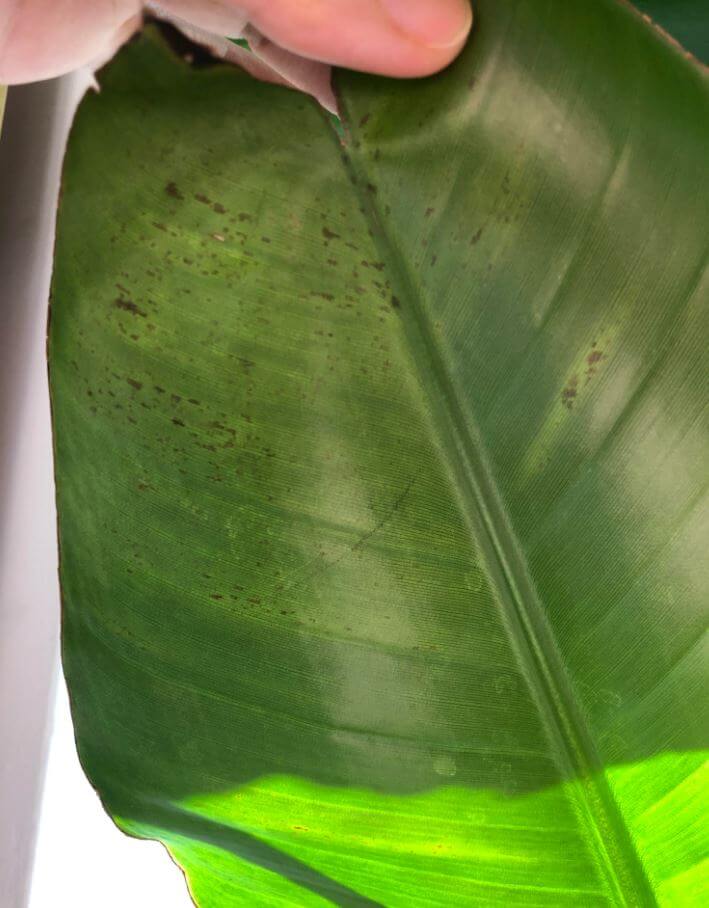
The most common causes of black spotting on these plants are diseases, pests, and overwatering. There are methods for preventing and treating black spots on bird of paradise plants.
Diseases and infections are the primary cause of black spotting. Consider these infections and what to do about them.
-
Leaf Spot
Commonly referred to as CercosporaLeaf Spot or Strelitzia Fungal Leaf Spot, this fungal infection typically appears when bird of paradise plants are overwatered. These fungi thrive in humid, moist environments with low light conditions and high humidity levels. Watering from above can also contribute.
Generally caused by the Coleosporium spp. Fungus spores are airborne and will germinate if they land on wet leaves. They appear in the form of circular or irregularly shaped patches and spots. Spot coloring can vary from black to gray to brown and occasionally yellow. When left unattended, they will spread and join to ruin the whole leaf. While this infection may not be fatal, it can destroy the leaf, causing curling and withering.
What to do
Isolate the affected plant to prevent spreading. Trim off all of the affected leaves and remove any fallen foliage. However, the best medicine is prevention. Preventing includes not watering from above and ensuring good air ventilation in the area of the plant. If your plant is already infected, use a fungicide. Organic neem oil is an excellent alternative to chemical solutions.
-
Bacterial Leaf Spot Disease
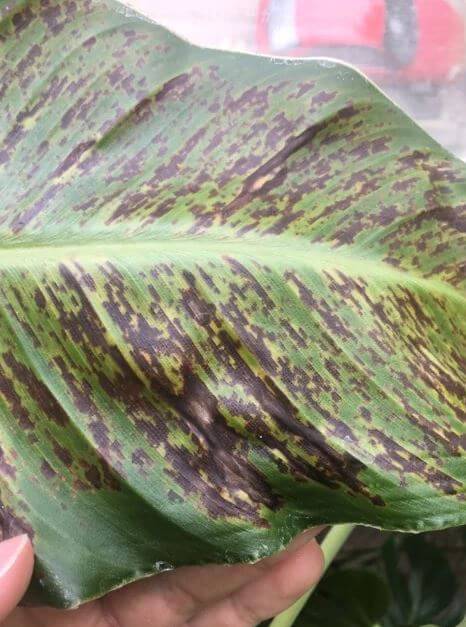
The Pseudomonas spp bacteria causes this disease. The initial symptoms will include yellow flecks and red streaks on leaf undersides. If this infection is not treated, black spots with yellow rings will follow. Stems will develop cankers and turn black, finally shriveling up.
What to do
Prevention is your only hope. Do not overwater or wet foliage. Once the disease takes hold, it is difficult to save the plant.
-
Sooty Mold
Sooty mold is likely the most common cause of black spots on Bird of Paradise leaves. Sooty mold is not an actual plant disease but is usually the result of a pest infestation. Sap-sucking pests like scale, mealybugs, or aphids will excrete honeydew. After feeding on the plant’s sap, they deposit this sweet, sticky substance on the plant. The spores of the mold will land on the honeydew and develop into fungal growths. Ants may appear shortly after that. While this mold will not penetrate or infect the plant per se, it will inhibit photosynthesis, and as the mold develops, it can gradually cover most of the plant.
What to do
Initially, you need to remove the source of the honeydew production, the pests. Treat your bird of paradise plant with an insecticidal soap spray or neem oil spray. You can also remove problems manually by wiping the plant down with cotton pads soaked in rubbing alcohol. Repeat this treatment every five days until there are no more signs of pests.
A few days after the final pest treatment, use a gentle detergent spray on the mold itself. After 15 to 20 minutes, use a jet water spray to wash down your plant until all mold spots have been eliminated. Trim off any heavily damaged plant parts.
-
Root Rot or Stem Rot
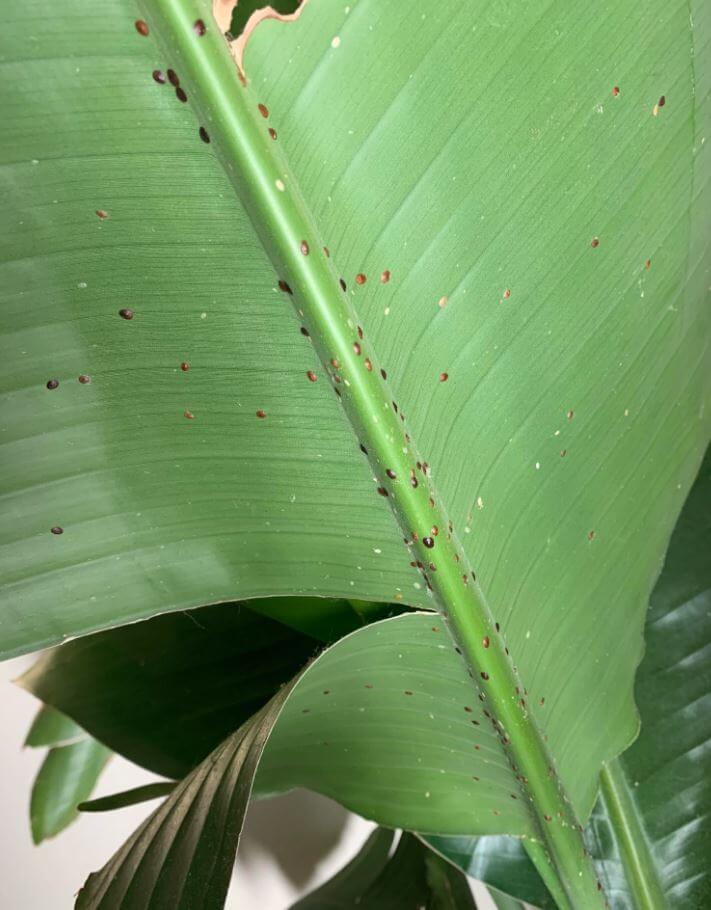
These rotting diseases appear when a plant has been overwatered and left standing in soggy soil. Usually caused by the Pythium spp. water fungus, you will see black spotting, yellow foliage, brown leaf tips, and wilting. Another root rot fungus is Armillaria, which causes brown and black speckling, stunted growth, and stem cankers. Phytophthora spp. also will cause fungal infections, usually from watering overhead.
What to do
Prune off all affected areas, move your plant to a spot with less humidity, and unpot your plant to access root system damage. Infected roots must be trimmed off and disposed of, not composted. Treat remaining healthy roots with a fungicide and repot your plant in clean, fresh potting soil in a sterilized container.
Black Spots on Bird of Paradise Stem
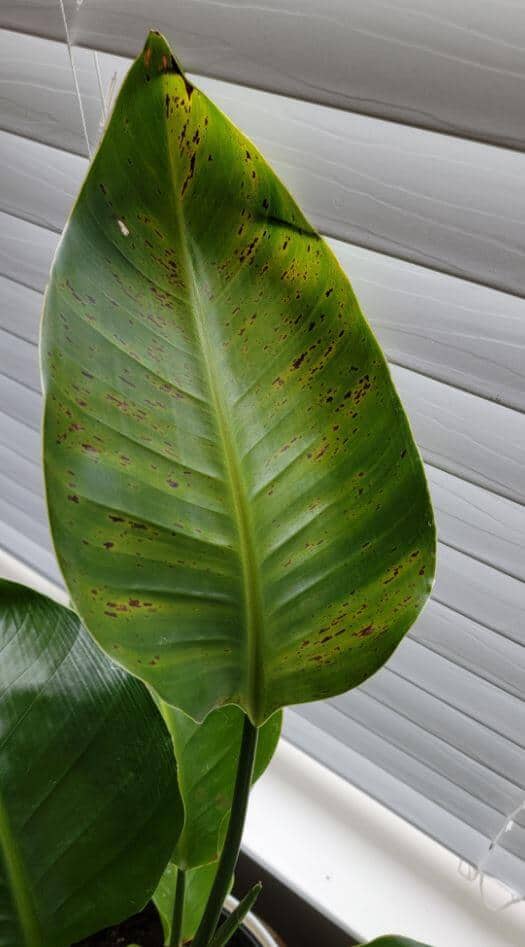
If the stem of your bird of paradise plant shows black spots, your plant may have been exposed to excess sunlight. Scorching afternoon sun is not recommended for this tropical gem. Black stem spots rarely indicate pest infestations or infections and usually indicate a sun exposure problem.
What to do
If you believe this to be the case, move your bird of paradise plant to another location. These plants love bright, indirect sunlight. If you must place it in a sunny spot, the sunlight should be filtered or diffused in some way. Sunburned foliage should be trimmed off.
Black Streaks on Bird of Paradise Foliage and Stems
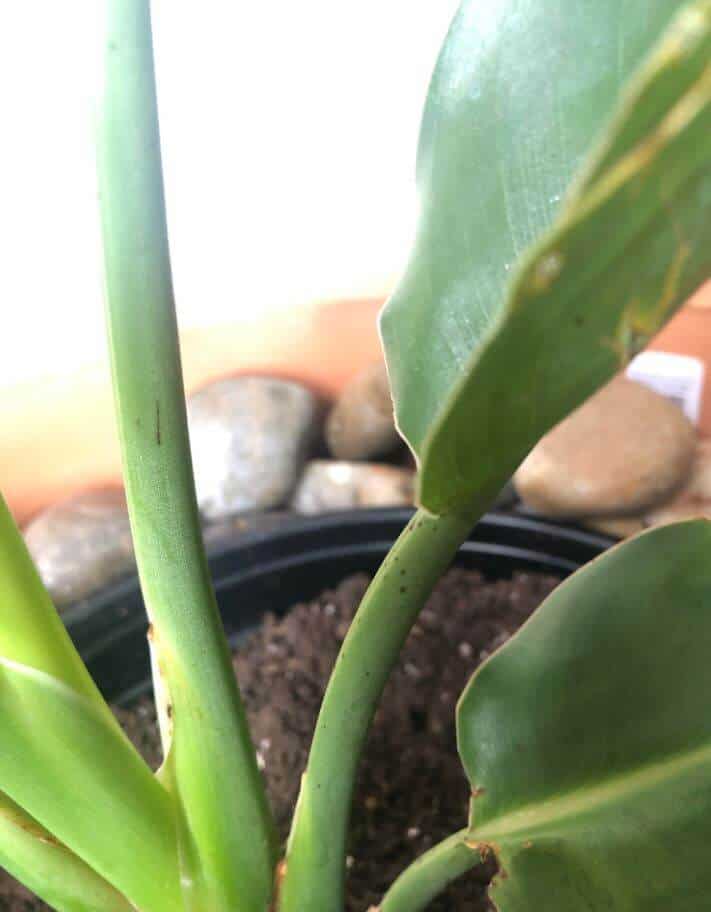
When black streaking appears, this generally indicates a pest infestation. Examine your plant thoroughly for signs of aphids, mealybugs, scale, or whiteflies. Most of these bugs may escape attention and be invisible to the naked eye, but the presence of sooty mold and ants will confirm this diagnosis. To eliminate black streaking, apply insecticidal soap, a horticultural oil spray, or use rubbing alcohol on the affected parts.
Overwatering a Bird of Paradise Plant
If your plant is left in soggy soil, it will drown the root system and be a potential breeding ground for fungal infections. Damaged root systems will no longer be able to absorb oxygen or necessary nutrients. Leaves will begin to yellow, and black spots will start to appear. In its weakened state, the bird of paradise will be susceptible to diseases and pest infestations.
What to do
If you have a mild case of overwatering, move your plant to a brighter spot to aid in drying out the soil bed. If you have a severe chance, you will likely have to treat the plant for root rot.


